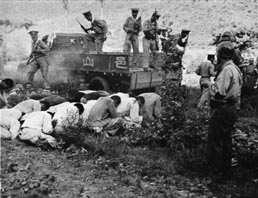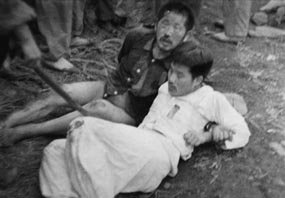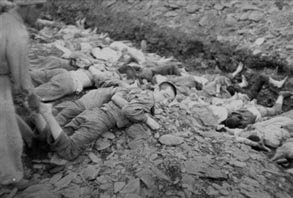58th Anniversary of the Korean War |
||||||||||||||
Hail the Historic Victory of the Korean People!U.S. Imperialism Out of Korea Now! |
||||||||||||||
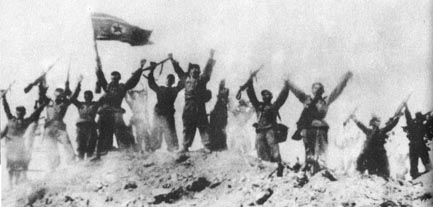 |
||||||||||||||
• Chilling to the Bone - John Cherian, www.alternatives.ca At 5:00 am on June 25, 1950, U.S. troops alongside troops of the U.S.-installed regime of Syngman Rhee invaded north Korea across the 38th parallel. The U.S. had forcibly divided the Korean nation in 1946 and instigated civil war |
||||||||||||||
Forces of the Korean People's Army celebrate victory on the battlefield. |
||||||||||||||
in 1950. The U.S. then launched its invasion of Korea underthe pretext of helping one country, the Republic of Korea (ROK), defend itself against the "aggression" of another, the Democratic People's Republic of Korea (DPRK), denying the reality that Korea was and is one nation. The U.S. then engineered a vote in the United Nations to carry on its invasion plans under auspices of the UN and with the participation of its allies. The U.S. imperialists' occupation of south Korea began in 1945, a result of Japan's surrender at the end of World War II, and entailed a systematic campaign to smash the Korean people's desire for the immediate reunification and independence of their country which had been annexed to Japan with the support of the U.S. from 1910 to 1945. Upon the arrival of the U.S. military in south Korea in 1945 to receive the Japanese surrender, the U.S. dissolved by force the peoples' committees there, ruthlessly suppressing the Communist Party, leftist forces and south Korean patriots. They rigged up the Syngman Rhee puppet regime in 1948, and created the south Korean puppet army. In 1949, the U.S. supplied the south Korean puppet army with 105,000 rifles, 2,000 machine guns, more than 50 million bullets, 5,000 military trucks, 79 warships and 20 fighter aircraft. The south Korean puppet army was expanded to 150,000 troops by 1950 which outnumbered the Korean People's Army of the north, which had about 80,000 to 90,000 troops. In January 1950 the U.S. concluded with its south Korean puppets the 'Mutual Defence and Aid Treaty.' These measures were in preparation for the military take over of all of Korea. |
||||||||||||||
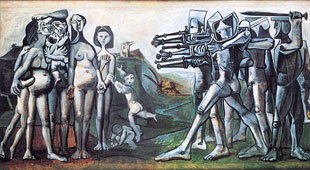 |
The U.S. imperialists and their allies committed untold crimes in the three years of the Korean War. The DPRK was literally razed to the ground. On Pyongyang alone, 428,748 bombs were dropped by the U.S. -- one per resident. The U.S. also used massive quantities of chemical and biological weapons against the Korean people and carried out numerous military massacres of civilians in its attempt to terrorize the entire Korean people into submission to the U.S. dictate. But despite the loss of over 4 million mostly civilian lives, the heroic struggle of the Korean people showed the world that the U.S. imperialists' military might is no match for a people united in the just cause of national and social liberation. The U.S. imperialists were handed an ignominious defeat and were forced to | |||||||||||||
| Massacre in Korea, painted by Pablo Picasso in 1951 in protest at the UN intervention in Korea | ||||||||||||||
| retreat south of the 38th parallel where they continued their offensive against the Korean people, an offensive which continues today. The refusal of the U.S. to date to sign a peace treaty with the DPRK to replace the Armistice Agreement the U.S. was forced to sign at the end of the Korean War on July 27, 1953 shows that the U.S. has not abandoned its aim of launching another war on the Korean peninsula for self-serving geopolitical aims. | ||||||||||||||
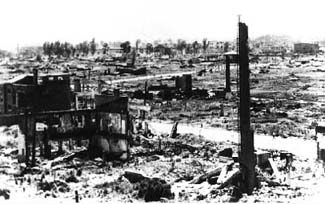 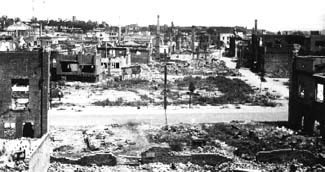 |
||||||||||||||
| The aim of the U.S. today is the same as it was then -- to take over the entire Korean peninsula as a launching pad for its takeover of Asia.The U.S. justification remains as bankrupt as ever. | ||||||||||||||
Pyongyang, DPRK, 1953, after U.S. bombing. |
||||||||||||||
All the attempts of the U.S. to realize its domination of the region -- its occupation of the Korean peninsula with over 30,000 troops as well as its military bases, the ongoing attempts to sabotage the Korean people movement for national reunification, and its engineering of various fascistic puppet regimes in the south, including the present regime of Lee Myung Bak and its continuous disinformation and propaganda that the "problem" in Korea is the "threat" from the DPRK -- have failed to silence the 70 million Koreans who are demanding with one voice the peaceful and independent reunification of their homeland, free from U.S. imperialist interference. The criminal role of the U.S. imperialists in Korea, from 1945 to the present, has been exposed for the whole world to see and the resolute struggle of the Korean people stands as an example for all the peoples of the world fighting against imperialist domination. Chilling to the Bone- John Cherian, www.alternatives.ca, June 17, 2008 - Evidence is emerging to show that during the Korean War innocent civilians were massacred by the South Korean authorities and the U.S. forces. The Korean War, which lasted from June 25,1950, until a truce was declared on June 27, 1953, was one of the most brutal wars fought after the Second World War. It was initiated by the United States at the height of the Cold War. Many atrocities and massacres of innocent civilians were reported but almost all the blame for the war crimes was put on North Korea and China, its main military backer at the time. Now more and more graphic evidence is emerging to show that many of the atrocities in South Korea were in fact committed by the South Korean government and the U.S. forces stationed in the Korean peninsula. It has also become clear that the mass killings were on occasion supervised by the U.S. Army. American military reports of the slaughter were stamped "secret" and filed away in Washington. Last year, some photographs of the mass killings taken by the U.S. Army were published. They show prisoners clad in white, with heads bowed in submission and hands tied, being thrown face down into a trench. South Korean executioners then shot them in the back of the head. A British journalist, Alan Winnington, working for the Communist Party USA newspaper Daily Worker, reported on the executions in the South Korean city of Daejeon in 1950 itself, but his reportage was dismissed as propaganda.
|
||||||||||||||
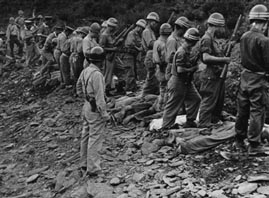 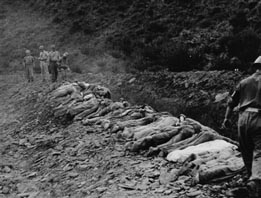 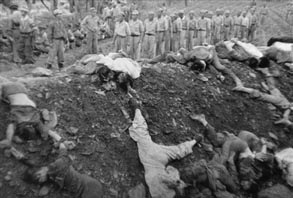 |
||||||||||||||
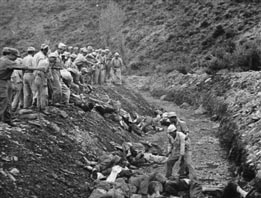 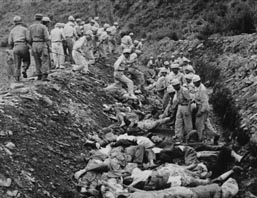 |
||||||||||||||
| U.S. Army photos depicting the summary execution of South Korean political prisoners by the South Korean military and police at Daejeon, South Korea, over several days in July 1950. Lt. Col. Bob E. Edwards, the U.S. Army Attaché in charge of documenting the executions, was quoted as saying, "General treatment of Prisoners of War after evacuation from front has been good." It is estimted that up to 7,000 were killed at Daejeon, and tens of thousands elsewhere. (Source: Brian Willson) | ||||||||||||||
Witnesses Come ForwardThe existence of a secret burial ground was accidentally discovered in 2002 after a typhoon uncovered one of the many mass graves. The Associated Press reported in the third week of May that more and more mass graves were being discovered near Daejeon. Then, one by one, witnesses who had been too scared to talk because of the authoritarian regimes that ruled South Korea until the late 1990s came forward to relate their first-hand experiences. The establishment of a Korean Truth and Reconciliation Commission in 2006 under former President Roh Moo-hyun, following the rapprochement between the North and the South, greatly facilitated the unearthing of new evidence. Before leaving office, Roh issued a public apology for a massacre that came to light in Ulsan, another city in South Korea. He described the massacres as "illegal acts that the then state authority committed." In 1950, the regime of U.S. puppet Syngman Rhee put 30,000 people in prison, accusing them of having leftist sympathies. The government also forced 300,000 peasants whose loyalties were under the scanner to join a state-sponsored National Guidance League. According to a member of the Truth and Reconciliation Commission, initial evidence suggests that all members of the National Guidance League were killed by the South Korean authorities. In Daejeon, in the summer of 1950, tens of thousand of leftists and poor peasants, including women and children, were massacred in cold blood by the South Korean army. A retired prison guard who participated in the executions told the A.P. that many of those shot were ordinary prisoners and illiterate peasants who "knew nothing about communism." According to media reports and recently declassified documents, U.S. Army officers were aware of the horrific acts being committed. The victims' bodies were unceremoniously dumped into open trenches or disused mines, or thrown into the sea. A South Korean television crew recently discovered a sealed mine full of the remains of such victims. Professor Kan Man-gil of Koryo University, a South Korean academic, observed that "since pictures were taken and official reports made to the U.S. government by the U.S. military, we cannot but examine the question of American responsibility for the massacre." Kim Dong-choon, a member of the Truth and Reconciliation Commission, told A.P. that the mass executions of 1950 were "the most tragic and brutal chapter of the Korean War." Kim said that the fact "that these bones have remained abandoned so long and so close to where we live means that our society is still at a barbarian stage." 100,000 ExecutedThe commission estimates that at least 100,000 South Koreans out of a population of 20 million were executed. Kim said that these estimates were very "conservative." The commission is investigating 215 cases in which the U.S. military is accused of indiscriminate killing of South Korean citizens. According to the contents of a declassified U.S. State Department cable, General Douglas MacArthur, the Commander of the U.S. forces in Korea, viewed the killings as "an internal matter." The South Korean army at the time was under his overall supervision. The State Department belatedly admitted last year that the U.S. Ambassador in Seoul wrote a letter in 1950 stating that the U.S. military had a policy of shooting approaching civilians. "If refugees do appear from north of U.S. lines, they will receive warning shots, and if they still persist in advancing they will be shot," he wrote in his letter to then Secretary of State Dean Rusk. Donald Nichols, a former U.S. Air Force Intelligence officer, wrote in his memoirs, published way back in 1981, about witnessing "the unforgettable massacre of approximately 1,800 in Suwon." Hundreds of civilians, mainly women and children, were killed in 1950 in No Gun Ri as they approached U.S. Army positions for protection after their village was overrun by the North's forces. The Commander of the U.S. 25th Infantry Division told his troops that all civilians seen in the area under his command "are to be considered as enemy and action taken accordingly." In another incident on September 1, 1950, a U.S. Navy destroyer fired at a refugee camp in Pohang. Survivors said that between 100 and 200 people were killed. |
||||||||||||||
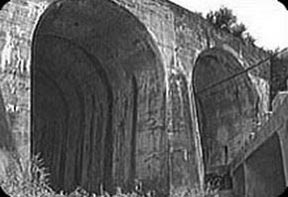 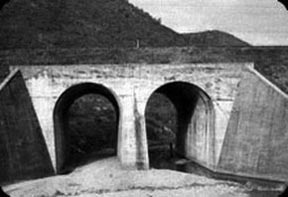 |
||||||||||||||
| Bridge at No Gun Ri: Korean civilians were instructed by U.S. troops to stand on the railroad tracks atop the bridge where the soldiers then searched them for weapons. The soldiers then radioed for an aerial bombardment and then fled. Of those who were not killed, many escaped to the tunnel beneath the bridge, where for the next four days, July 26-29, soldiers fired at them. U.S. medics visited the group, but did not offer help. (Source: www.askasia.org) | ||||||||||||||
A retired U.S. Army clerk, who served in Korea during the war, testified to typing a report written by the commanding officer admitting that 300 refugees were fired on at No Gun Ri. The survivors of No Gun Ri sought acknowledgement and reparations for the killings from the U.S. government in 1960. But the U.S. war claims office in Seoul said the petitioners had missed the deadline for filing the claims. In 1997, after another petition was filed, the U.S. authorities claimed that the U.S. Army was not in the area when the massacres occurred. |
||||||||||||||
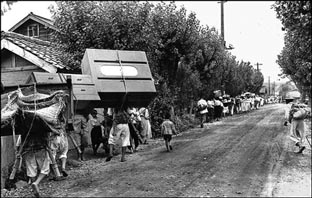 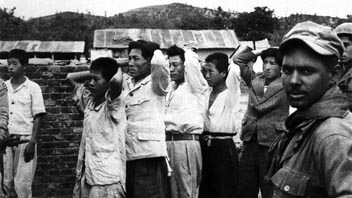 |
||||||||||||||
| Left: A long line of refugees fled Yongdong, South Korea, on July 26, 1950. The same day, eight miles down the road at No Gun Ri, hundreds of refugees came under fire from U.S. troops. A letter has come to light indicating the killings were part of U.S. policy. Right: In this undated photo suspected communist collaborators were rounded up in Yongdong. |
||||||||||||||
|
The U.S. military involvement in Korea ranks among the bloodiest chapters in American history. It was a test run for the wars in Vietnam, Iraq and Afghanistan, where the U.S. military has targeted unarmed civilian populations. In the Korean War, two million civilians were killed in the three years of fighting. The U.S. armed forces used more bombs and artillery shells than were used during the Second World War. It was during the Korean War that U.S. forces started using napalm against military and civilian targets. Former U.S. Air Force General Curtis LeMay boasted that U.S. planes had "burned down every town in North Korea" and killed "20 per cent of the population of Korea as direct casualties of war or from starvation and exposure." Kim Man-sik, who was a military police sergeant in 1950, told The New York Times last year about communist suspects being tied together with military communications wire. "So when we opened fire, they all pulled at each other to try to escape. The wire cut into their wrists. Blood was splattered all over their white clothes," Kim Man-sik told the Truth and Reconciliation Commission. The survivors and relatives of those killed continue to be victimised. Kim Sung-soo, a member of the commission, observed in a recent article in The Korea Times that "the bereaved families, guilty by association, are not allowed to get decent jobs or work in the public sector, police tailed them wherever they went and their children were bullied in school." |
||||||||||||||
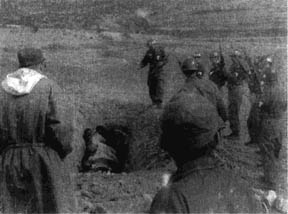 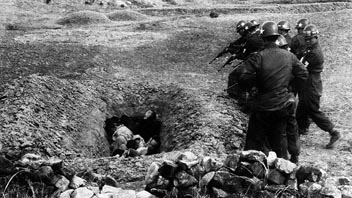 |
||||||||||||||
| Left: U.S. military officers overseeing South Korean executions of civilians "suspected of collaborating" with the "communists," near Taegu, south Korea, April 1951. Photos taken by U.S. Korean Military Advisory Group (KMAG). | ||||||||||||||
|
The new conservative government in power in Seoul is known to be unsympathetic to the commission. The rightist complaint is that the commission will only reopen old wounds. The fear is that President Lee Myung-bak, whose party traces its roots to the authoritarian right-wing regimes of the 1950s, may cut funding for the commission, which with an annual budget of $19 million and a staff of 280, is constitutionally mandated to serve until 2010. The commission will issue a final comprehensive report on the anti-Japanese movement during the colonial period and the history of the Korean diaspora, the massacre of civilians after 1945, human rights abuses by the state, and incidents of dubious convictions and suspicious death. Back to topReport of the Investigation Team of the International Association of Democratic Lawyers on the Crimes Committed by the United States in KoreaMarch 31, 1952 Right in the middle of the Korean War, an investigation team of the International Association of Democratic Lawyers went to north Korea to investigate U.S. war crimes being committed against the Korean people. This is an extract of their report.*** The United States conducted indiscriminate bombing raids on the Democratic People's Republic of Korea in wanton violation of the norms of the International laws and humanitarian principles during the past Korean War. The U.S. troops used germ and chemical weapons and committed genocide, and consequently, many innocent civilians were mercilessly killed and industrial facilities, schools, hospitals and other cultural establishments for peaceful purposes were destroyed. In order to investigate the genocide committed by the U.S. against the Korean people, the International Association of Democratic Lawyers formed a legal-expert investigation team from 8 countries including Austria, Italy, Britain, Netherlands and France. This team visited the Democratic People's Republic of Korea (DPRK) from March 3 to March 19 in 1952. The team made public the following result of its investigation. I. Bacteriological Warfare of the United States:When the team arrived in Korea, it was immediately faced with an unexpected task to look into a very serious case of the U.S. army troops in Korea using bacteriological weapons against the Korean army and non-combatants. The team members collected first-hand evidence at various local places of this country. In many cases, the team found a special variety of flies, fleas, spiders, beetles, bedbugs, crickets, mosquitoes and other insects. Most of them were not native to Korea. Most of them were found on the snow and icy rivers or between grasses and stones, far away from inhabited areas. At these times, the temperature (one degree centigrade in January and 5 degrees centigrade in February at maximum) was extremely low making it impossible for the insects to survive. And different insects including flies and spiders were often found at the same place in large mixed groups, even though they normally did not fly in-group. In consideration of all this, appearance of these insects in the above place was deemed unnatural. The expert investigation proved that the virus infected the insects. (1) On January 30 1952, flies, bedbugs and spiders were found alive on snow and between stones in the eastern and southern areas of Ichon, Kangwon Province. A subsequent investigation by the experts had determined that the flies were infected with the cholera virus. Debris of a container was found 3-4 meters away from the place where the insects were discovered. The container was designed to open up immediately upon impact. (2) On February 18, 1952, flies, spiders and ladybirds were found in Balnam-ri, Taeri sub-county, Anju county in South Pyongan Province. The insects all survived. At this time of the year, such flies and spiders were never seen in this region. The temperature above ground was 20 degrees centigrade below zero. The expert investigation concluded the infection of' the insects by pest virus. (3) On February 25, 1952, flies and other insects were found 5 times in Kaechon county, South Pyongan Province. The insects discovered were the first ever to be found in this region. (4) Qn March 3, 1952, a swarm of flies was found to have been bundled together in one square yard in Koum-ri, Jasan sub-county, Sunchon County in South Pyongan Province. The flies were found on snow at 10 degrees centigrade, but they were still alive. It was abnormal to see flies at the outdoors at this time of the year. (5) On March 5, 1952, flies were found swarmed in small and large numbers on the road in Nammun-ri, Junggu, South Pyongan Province. Next day, cholera broke out. These individual cases documented by the inspection team represent only a small portion of the facts, because the inspection team could not visit every affected place. It was proven that pest cholera and other contagious diseases infected a large number of the insects. Containers were discovered near the place where the insects were found. They were structured to be used for carrying the insects in large numbers. The containers were confirmed to have carried a plate written in English. There occurred an outbreak of pest and cholera immediately after the insects were found. The investigation team could not but reach the conclusion that the U.S. planes dropped insects in Korea that were infected by contagious diseases. II. Use of Chemical Weapons by the U.S.The U.S. planes used suffocative and other gases at least from May 6, 1951. (1) On May 6, 1951, three B-29 bombers dropped bombs in Samhwa-ri, Hupo-ri, Chukdong-ri, Yongjong-ri and Yongsu-ri between 5:05 and 6:30 p.m., killing 1,379 people. Among them, 480 people died by suffocation and 647 people were gas-poisoned. The symptoms of the dead were as follows; breathing difficulty, hoarse voice, dizziness, coughing, tears, snivels, pain and vomits of blood. In the regions bombarded by gas bombs, grass changed its color into yellow brown and things including copper alloy into blue green and silver rings into dusty color. (2) On September 1, 1951, two bombs were dropped in one village of Yonsong-ri and Wonchol-ri, Hwanhae Province. Contrary to the normal bombing, this bombing produced a fainter noise and exploded in the air producing black smoke. A yellowish green cloud spreading on the ground surface followed this. As a result, four civilians died and 40 other people were poisoned. And the symptoms and the results were similar to the ones found in the bombardment of Nampo on May 6, 1951. (3) About 4 p.m. January 9, 1952, two bombers dropped bombs in a village called Hakson-ri located in the north of Wonsan. After that, 38 people were poisoned. Those symptoms were similar to those found during the Nampo bombardment. The above facts prove undoubtedly that the U.S. troops in the Korean War possessed all kinds of chemical weapons and used them on many occasions to kill the civilian population and caused many casualties. III. Massacre by the U.S. in Sinchon:35,383 inhabitants (19,149 men and 16,234 women) were murdered in Sinchon County during the period of the U.S. troops occupation of Sinchon from October 17 to December 7, 1950. The investigation thereon gave its conclusive evidence on the following facts: (1) The U.S. troops killed about 900 men and women including about 300 children behind the building of the County People's Committee on October 18, 1950. Included in the victims were pregnant women. (2) The U.S. troops confined 400 people to an underground facility and burnt them alive in the area of Pujong-ri on October 18, 1950. The burnt bodies remained in the underground until this area was liberated. (3) The investigation team inspected the graves where the October 20, 1950 massacres occurred. Some were unearthed in the presence of the investigation team. The team also visited the air-raid shelter and the warehouse where the October 20, 1950 massacres were committed. Burn marks were found on the walls of the sites. (4) Another massacre was committed in mid-November, 1950. Nearly 500 people were killed including women and children. (5) The U.S. troops buried almost 400 people alive in Sangsong-ri of Yongjin sub-county, Sinchon County. During the occupation, the U.S. troops arrested 2,000 inhabitants and employed numerous methods in killing them in Solmae-ri of Rowol sub-county, Sinchon County. (6) On December 7, 1950, when the U.S. troops were forced to retreat in the Sinchon area, they murdered about 900 men and women at two warehouses in the area of Wonam-ri on the order of U.S. Army Lieutenant Harrison, the then commander of the U.S. troops occupying that area. More than 200 children were also killed inside one of the warehouses. The U.S. troops poured gasoline over the clothes of the victims and set them on fire and then threw hand-grenades inside the building through the windows. A Korean woman locked in the building together with her two children managed to push her children through the window. But one child was shot to death and the other escaped. The mother was burnt to death. Such crimes committed by the U.S. troops in Korea are not isolated incidents, but they were planned and deliberate criminal acts by the U.S. commanders and they have caused detrimental effects on world peace. A New Look at the Korean War- John H. Kim, Veterans for Peace, 2000 (Excerpts) - In an essay written in 2000 entitled, "A New Look at the Korean War," John H. Kim, a U.S. Army veteran and the Chair of the Korea Committee of the Veterans for Peace, highlights among other things, the events leading to the outbreak of the Korean war and the crimes that were committed by the U.S. during the war and after. The author also calls on the U.S. to take responsibility for these crimes against the Korean people. The following are excerpts.*** Outbreak of the Korean WarThe official American history is that the Korean War started on June 25, 1950 when the North Korean forces suddenly attacked the south under Stalin's order. This is a gross misrepresentation of the origin of the War. For one thing certain now, according to Russian declassified documents, Stalin did not order Kim Il Sung to start the War. [...] The truth is that the Korean War really started in 1945 when the U.S. suppressed the KPR government and imposed its military rule in the southern part of Korea. During the American Military Government (1945-1948) and the period from the establishment of the Republic of Korea (ROK) in the south in August 1948 to the full-scale war in June 1950, the U.S. military and the fascist Rhee regime, allied with pro-Japanese Koreans, either imprisoned or killed hundreds of thousands of Korean nationalists and socialists in order to establish a separate, pro-American government in the south. This savage repression resulted in bloody armed struggle by the angry Korean peasants, workers, students, and soldiers all over southern Korea. Major armed uprisings took place in Daegu, Cheju Island, Yosu, and Sunchon. In Cheju island alone from 1948 to 1949, more than 30,000 Koreans were killed, out of a population of 300,000, by the south Korean police/military forces and right-wing youth gangs under the direction of the American military officers. In addition to the widespread guerrilla warfare in the South, major battles also broke out between the north Korean (DPRK) and south Korean (ROK) armies along the 38th parallel line in 1949. The first major battle, initiated by the ROK troops near the border city of Kaesong, took place on May 4, 1949, lasting four days with hundreds of soldiers being killed. The fighting also occurred in June 1949 in the Ongjin peninsula, the same area where the official Korean War would "begin" one year later. Then another major battle also broke out in August 1949. Thus, when the armed clash broke out in June 1950, it was more or less a continuation of the past conflicts. It was certainly not a surprise attack. The anti-communist dictator Syngman Rhee was openly preaching a military unification of Korea by attacking the north. At the same time, the north Korean leader Kim Il Sung was also preparing for a military counter-attack against the south when Rhee attacked. The U.S. was fully aware of the tense situation and took advantage of it for justifying its rapid, gigantic military build-up plan which was first presented in April 1950 as National Security Council resolution #68. When the fighting started on June 25, each side accused the other for starting the war. Under this murky picture, President Truman nevertheless labelled the civil war as a naked aggression of communist world against a free nation, and intervened in the war under the UN flag to avoid an official declaration of war in the U.S. Congress. Truman characterized his decision as a "police action." |
||||||||||||||
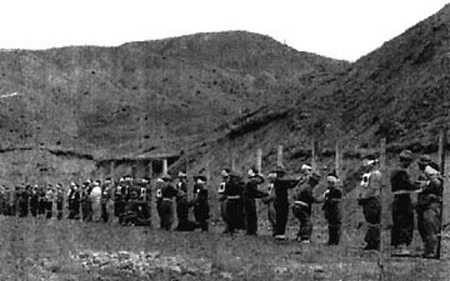 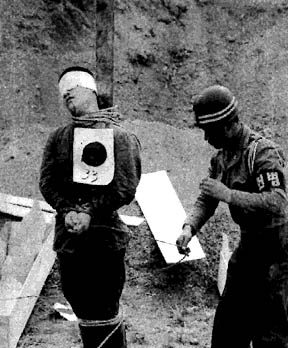 |
||||||||||||||
| April 14, 1950, more than two months prior to the beginning of the "hot" war, thirty-nine Korean civilians "suspected of being communists" were tied up to poles and blindfolded, with bull's eyes pinned over their hearts, just before being shot by South Korean Military Police firing squad, ten miles northeast of Seoul, Korea. Six U.S. Army officers observed this execution including the U.S. Army Attaché. (Source: Brian Willson) | ||||||||||||||
U.S. AtrocitiesThe Associated Press' stunning report in September 1999 on the massacre of several hundred Korean civilians by U.S. soldiers in late July 1950 near Nogun-ri was a historical turning point in revealing the true history of the Korean War. It is the beginning of the unmasking of the official American lies. And it is just the tip of an iceberg. In addition to the crime of aggression, the United States committed numerous war crimes, crimes against humanity and genocide, in violation of the international humanitarian law, during the Korean War. They can be summarized as follows: 1) Massacre of Korean Civilians The U.S. Army, Air Force and Navy were directly involved in the killing of over 3 million Korean civilians -- both south Koreans and north Koreans -- at many locations throughout Korea, including Masan, Sachon, Tanyang, Iksan, Changyong, Wegwan, Ducksung, Sinchun, Wonsan, Pyongyang, etc. Several hundreds of civilians refugees were blown apart when the U.S. Army blew up Wegwan and Ducksung bridges in south Korea. North Korean government claims that more than 35,000 north Korean civilians were massacred at Sinchon county during the U.S. military occupation of the area near Pyongyang. One report indicates that the 7th Regiment of the 1st Cavalry Division, which traces its infamous history all the way back to General Custer, was the same unit which was involved both in Nogun-ri and Sinchon massacres. Among the several branches of the U.S. military, the U.S. Air Force was probably more responsible than any other branches for the huge number of civilian killings because of its indiscriminate shootings and bombings of civilian refugees, villages, towns, and cities in violation of Hague Conventions. At the end of the war, almost all the north Korean cities were levelled to the ground by carpet bombing, including Pyongyang, Najin, Shiniju, Wonsan, Hungnam, etc. It is reported that the U.S. dropped some 650,000 tons of bombs, including 43,000 tons of napalm bombs, during the Korean War. (Cumings, The Origins of the Korean War, Vol. II; Hart-Landsberg, Korea; and The Korea Herald, 10/9/1999) 2) Destruction of Economic Sites The first air bombing of North Korean dam occurred in May 1951 when the U.S. Navy planes torpedoed the gates of Hwachon dam. In April 1952, Air Force Brigadier General Jacob E. Smart's staff drew up plans for strikes against the N. Korean power plants to destroy the economy of N. Korea. Gen. Matthew Ridgway and later Gen. Mark Clark endorsed these "air pressure" strikes. On June 23, 1952, Navy dive bombers from four carriers, covered by Air Force Sabres, attacked the Sui-ho hydroelectric power generation facilities located near Yalu River. Other power generation facilities were also bombed the next day. These attacks on power plants reduced N. Korea's power generation capacity by 90%. At Smart's suggestion, Air Force-Navy planes also struck north Korea's military plants and oil refinery sites. U.S. also destroyed five irrigation dams 27 miles north of Pyongyang in May 1953 through air bombing. The latter was intended to deny food to north Koreans. (Stanley Sandler, Editor, The Korean War: An Encyclopedia, 1995, pp.231-237.) 3) Rape/Murder of Korean Women and Girls by U.S. Soldiers Numerous incidents of individual and group rapes of Korean girls and women have been reported both in south and north Korea during the War. This problem still persists in south Korea even today due to the continuing presence of some 37,000 U.S. troops there. (Cumings, The Origins of the Korean War, Vol. II & International Association of Democratic Lawyers, Report on U.S. Crimes in Korea, 1952) 4) Chemical/Biological Warfare North Korea reported that American war planes dropped chemical bombs on the north Korean military positions as well as on villages, resulting in hundreds of north Korean civilian deaths. U.S. also experimented with biological weapons in the north, with the active assistance of the Japanese war criminals who were involved in human experiments during WWII. (Stephen Endicott, The U.S. & Biological Warfare: Secrets From Early Cold War and Korea) 5) Mistreatment of POWs Thousands of north Korean and Chinese POWs died due to deliberate shooting and torture by the prison guards, starvation and medical experiments. General Crawford Sam's so-called bubonic plague ship, Landing Craft No. 1091, was stationed in the Koje Island where the majority of the POWs were kept. The ship is suspected to have used the POWs to work out certain aspects of germ warfare. (Hugh Deane, The Korean War) 6) Threatening Use of Atomic Bombs On July 9, 1950, MacArthur sent a "hot message" to Joint Chiefs of Staff (JCS) suggesting use of atomic bombs. On November 30, 1950, Truman himself threatened use of weapons of mass destruction, including atomic bomb, at a news conference. In December 1950 MacArthur asked for commander's discretion to use nuclear bombs requesting 34 of them. He also proposed spreading a belt of radioactive cobalt across the neck of Manchuria. In June 1951, JCS considered use of atomic weapons in tactical battlefield circumstances. Simulated atomic bombing runs were conducted by B-29s from Okinawa (Operation Hudson Harbor). In Sept. and Oct. of 1951, Truman approved this experiment. In April 1953, President Eisenhower approved a contingency plan -- NSC147 -- providing for atomic attacks on Communist air bases and lines of communication and transportation to force acceptance of Armistice agreement. (Cumings, Korea's Place Under the Sun) 7) Assassination Attempt on Kim Il Sung The American CIA sent a Cherokee American Indian code-named "Buffalo" to north Korea during the War to kill the north Korean leader Kim Il Sung with promise of a large sum of money in case of success. He obviously failed in his mission. (Joseph C. Goulden, Korea: The Untold Story of the War) 8) Engaging in International Piracy and Murder In another secret operation code-named "TP-Stole" in 1951, the CIA intercepted in international waters a Norwegian ship, loaded with medical supplies and volunteer doctors and nurses, which was heading toward Manchuria. The medical supplies were taken away by the Taiwan Coast Guard personnel disguised as pirates and the medical personnel were probably killed off. The medical supplies and personnel had been provided by the Indian government as a humanitarian aid for the wounded Chinese soldiers. This operation was directed by Hans Tofte, the CIA chief in the Far East under direct order from the CIA headquarters. (Joseph C. Goulden, Korea: The Untold Story of the War) 9) Conspiracy to Remove/Murder Syngman Rhee As the south Korean President became more dictatorial and sometimes refused [to follow] U.S. orders, the Truman administration authorized General Clark, the U.S. Commander in Korea, to take contingency measures ("Operation Everready") to arrest Rhee and install a south Korean general, who would be more obedient to the U.S. order, as new head of a military government. The plan seems to have authorized killing off Rhee if necessary. (Goulden, Korea;Cumings, The Origins of the Korean War, Vol. II) 10) Mass Murder of Korean Political Prisoners At the outbreak of the War, the south. Korean regime had some 100,000 political prisoners in jails. As the S. Korean military retreated to the south, the Rhee regime apparently issued orders, with possible approval of the U.S. advisers, to kill all the political prisoners. These prisoners were taken to the fields, mountains or seas and executed by the south Korean police or military police, often in the presence of U.S. military advisers or intelligence agents who took pictures of the mass killings. Lt. Col. Bob E. Edwards, the military attaché to the U.S. Embassy in South Korea, had sent secret reports of these executions with photos to the Joint Chiefs of Staff. However, the official U.S. Army's history of the Korean War incredibly blamed the north Korean troops for this horrendous mass murder. In addition, hundreds of thousands of north Korean civilians who were followers or suspected supporters of the north Korean government were arrested and executed in cold blood during the U.S. occupation of the DPRK in October and November 1950. (The New York Times, 4/21/2000; Roy Appleman, South to Naktong, North to Yalu, office of the Chief Military History, 1961; Cumings) While the Pentagon was forced to reinvestigate the Nogun-ri massacre, the Clinton administration refused to investigate other war crimes or crimes against humanity that happened in Korea. In order to prevent any future happenings of similar atrocities, the U.S. Congress should establish a special commission to investigate the entire conduct of the U.S. officials during the Korean War. If the Congress does not do so, then it is incumbent upon the United Nations and American people to establish such a commission of inquiry. After all, these massacres were carried out in the name and under the authority of the United Nations and the U.S. In addition, in accordance with the result of the investigation, the gross sufferings of the victims of the atrocities should be fully redressed, including prosecution of those responsible for the atrocities and fair compensation to the victims Developments Since the Armistice AgreementThe bloody fighting which raged for more than three years finally stopped with an Armistice Agreement on July 27, 1953. It was signed by the U.S., north Korea and China, but not south Korea due to a strong opposition of the former dictator Syngman Rhee. Several million people are believed to have died during the war, including some two million north Korean civilians and one million south Korean civilians. Out of some 5.7 million Americans G.I.s who had served in the Korean War, about 54,000 American soldiers died in combat or from other causes. North Korea is believed to have lost more than 20 percent of its prewar population with a total destruction of its cities and towns. The cease-fire line, drawn along the actual fighting front, resulted in more or less the same division of the country along the 38th parallel. This artificial, cruel division of the homogeneous people, with some ten million victims of separated families, has been a continuing source of tensions and human sufferings. Although the Armistice agreement provided that an international conference be held within three months of signing the armistice "to settle through negotiation settlement of the Korean question, etc.," the U.S. was more anxious to conclude a mutual defence treaty with S. Korea. This defence treaty, signed on Oct. 1, 1953, is indefinite in duration and grants free military bases to the U.S. military in south. Korea. One important, enduring consequence of the War has been the U.S. military's control over the South Korean military. It is alleged that Rhee gave the command authority of the south Korean Armed Forces to Gen. MacArthur in July 1950. The legality of this action is in question. In any case, this subservient relationship between the U.S. and south Korea has continued after the War. To deflect the growing criticism of south Koreans over this neo-colonial arrangement, the two governments created a "Combined Forces Command" over the S. Korean and U.S. military forces in 1978. Up until late 1994, this meant the commander of the U.S. Forces/Korea had operational control of south Korean Armed Forces even in peacetime (now, it's only in wartime). Under this new arrangement, the U.S. Commander in S. Korea wears three hats as the Chief Commander of the UN Command, Combined Forces Command, and U.S. Forces/Korea. It is to be noted that, under this bizarre military arrangement, the U.S. will automatically get involved in another war if the Korean War is re-ignited, without any declaration of war by the U.S. Congress. In 1958 the Chinese troops withdrew from North Korea. Instead of reciprocating the Chinese move, the U.S. strengthened its military power in south Korea by bringing in tactical nuclear weapons there in clear violation of the Armistice agreement [...] Conclusion[...] It is high time for the U.S. to recognize its heavy responsibility for the division of Korea and the terrible destruction and killing of several millions of Korean civilians in the tragic War. It's about time that the U.S. government offers a sincere apology to the Korean people, seeks a permanent peace settlement in Korea, and normalizes its economic and diplomatic relations with north Korea fully, discarding the Combined Forces Command, and starting a gradual withdrawal of our troops from South Korea. Such a peace settlement at this time, whether in the form of a peace treaty or other agreement, will be highly beneficial not only to both Koreas but also to the United States since the U.S. wouldn't have to proceed with the building of the expensive "star wars" national missile defence system, which may cost more than $300 billion. Under this new win-win policy, we can really help the Koreans to achieve an independent, peaceful reunification of Korea and bring about a new era of peace, prosperity and friendly cooperation in the Far East. Unfortunately, the Bush administration is escalating tensions on the Korean peninsula by accusing North Korea as [part of] an "axis of evil" and contemplating a pre-emptive strike against North Korea. At this dangerous time of an indefinite "war on terrorism" that may easily be extended to Korea, it is all the more important for concerned American people, especially veterans working for peace and reconciliation, to start raising their voices in demanding a final end to the Korean War and a new policy toward Korea. [The Korea International War Crimes Tribunal on U.S. troop massacres of civilians during the Korean War took place in New York City in June 23-25, 2001 and the final verdict found the U.S. government and military from the period of end of the Second World War guilty of war crimes, crimes against humanity and crimes against the peace against the Korean people.]. |
||||||||||||||
| Back to top Back to Index/Home Page | ||||||||||||||
